Few sights in a summer garden are as refreshing as lush green cucumber vines stretching toward the sky, dotted with crisp, cooling fruit. While cucumbers can sprawl along the ground, allowing them to climb vertically — on trellises, fences, or netting — is a game changer. Proper support not only saves space but also keeps fruit cleaner, healthier, and easier to harvest.
If you’ve ever struggled with tangled vines, misshapen cucumbers, or pest problems, it’s time to learn the right way to support climbing cucumbers. With a bit of structure and know-how, your vines will thrive, and your harvest will be abundant.
Why Support Matters for Cucumbers
Cucumbers are natural climbers. In their native tropical habitats, wild cucumber vines use tendrils to grasp onto nearby plants and structures, climbing toward sunlight. Providing a support system replicates this natural habit and brings several benefits:
- Healthier Plants: Air circulates better around upright vines, reducing fungal diseases like powdery mildew.
- Cleaner Fruit: Cucumbers growing off the ground stay clean, straight, and blemish-free.
- Better Yields: Plants that climb receive more sunlight, leading to stronger growth and higher fruit production.
- Easier Harvest: No need to dig through dense foliage — the fruit hangs visibly for quick picking.
- Space Efficiency: Vertical gardening maximizes limited garden space, perfect for small backyards or container gardens.
Step 1: Choose the Right Cucumber Variety
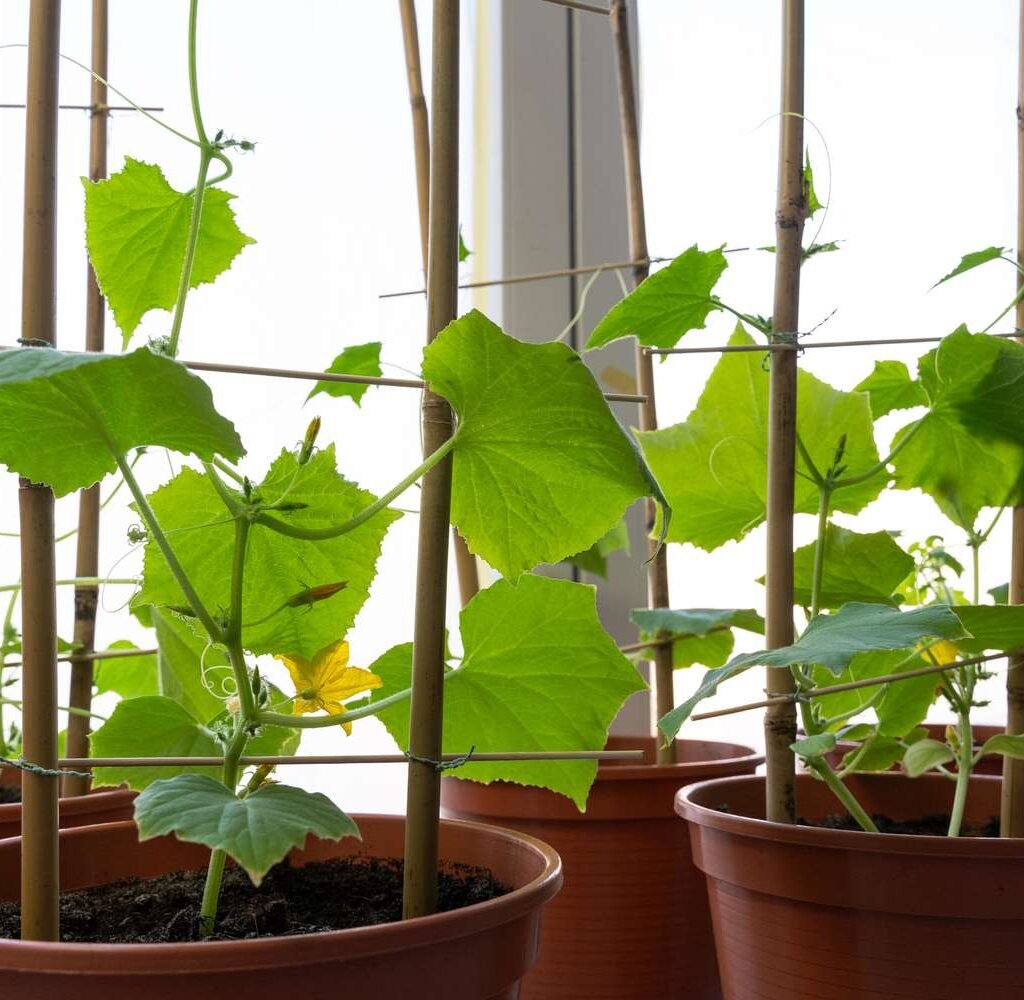
Not all cucumbers are equally suited for climbing. While most varieties have tendrils and can climb, some perform better than others when grown vertically.
Best Climbing Varieties:
- ‘Marketmore 76’: A reliable slicer that grows well on trellises.
- ‘Straight Eight’: Classic cucumber with vigorous vines and long fruits.
- ‘Lemon Cucumber’: Round, yellow fruits that do great when supported.
- ‘Telegraph Improved’: Long English cucumber perfect for greenhouse or vertical growing.
- ‘Boston Pickling’: Great for pickles and trellis growing.
If you’re short on space, look for vining (not bush) types. Bush cucumbers tend to stay low and compact — great for pots, but not ideal for climbing systems.
Step 2: Prepare the Soil and Location
Cucumbers love warmth, sunlight, and well-draining soil. Before setting up your support, make sure your site is ready.
Ideal Growing Conditions:
- Sunlight: At least 6–8 hours of full sun daily.
- Soil: Rich, loose, and slightly acidic (pH 6.0–7.0).
- Drainage: Avoid soggy soil — cucumbers hate “wet feet.”
- Spacing: Plant seeds or seedlings 1 foot apart at the base of the trellis or support.
Mix compost or aged manure into the soil before planting to give your cucumbers a strong start.
Step 3: Choose the Right Support System
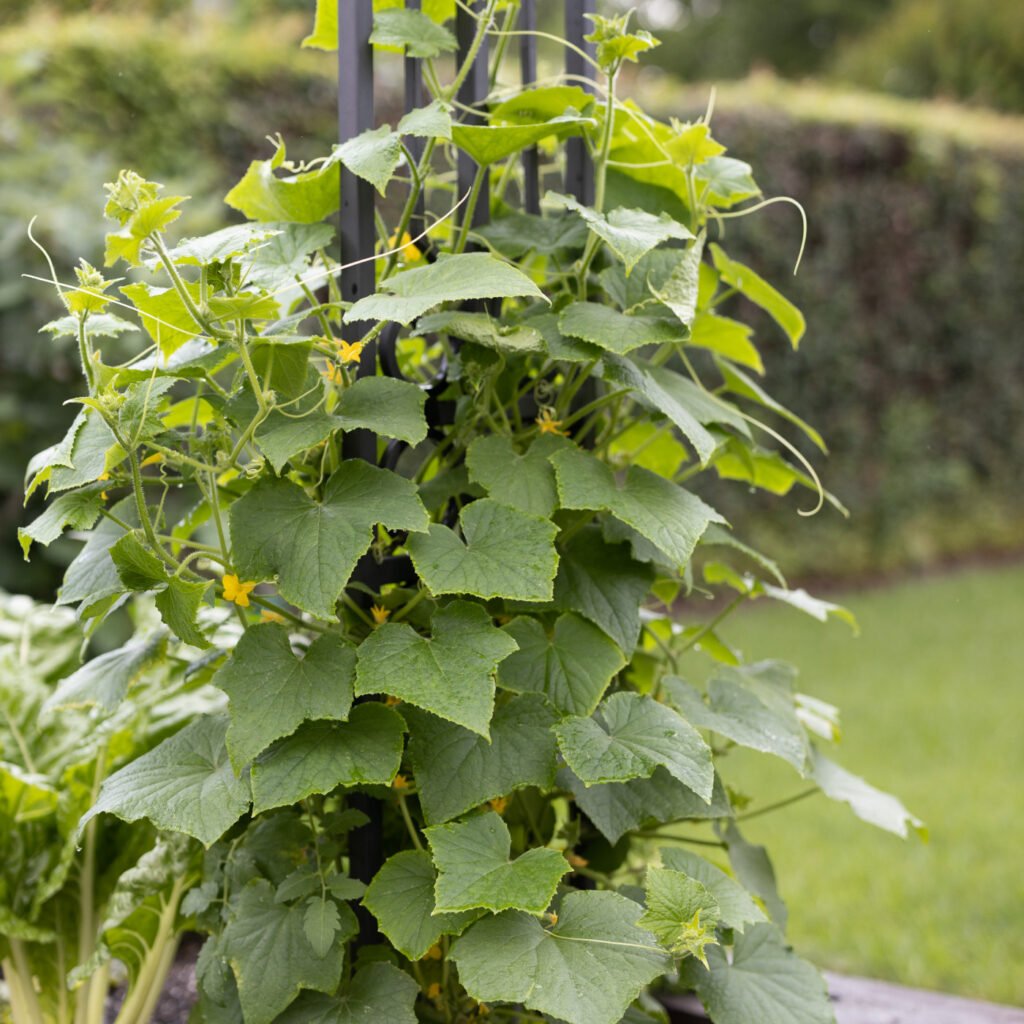
There’s no single “best” structure — the right support depends on your garden size, materials, and growing style. Here are several tried-and-true options:
1. A-Frame Trellis
A sturdy, two-sided frame that forms a triangle shape. Perfect for raised beds or garden rows.
- Pros: Easy to access from both sides, strong enough for heavy vines.
- How to Make It: Use wood, bamboo, or metal poles and cover with garden netting or wire mesh.
2. Vertical Trellis or Fence
Attach cucumber vines to a tall, straight structure such as a wire fence, wooden lattice, or garden arch.
- Pros: Simple and space-saving.
- Tip: Ensure it’s at least 5–6 feet tall, as cucumber vines can grow quite long.
3. String or Netting System
Ideal for greenhouses or vertical gardens. Use strong nylon string or garden netting attached to a top support beam.
- Pros: Lightweight, flexible, and great for training vines upward.
- Tip: Regularly guide tendrils to prevent tangling.
4. Tomato Cage or Obelisk
Smaller gardens or containers can benefit from cylindrical supports like cages.
- Pros: Portable and easy to set up.
- Cons: Limited space for large, vigorous vines.
5. Arch or Tunnel Trellis
An eye-catching and practical structure that allows vines to form a shaded archway.
- Pros: Great for aesthetics and easy harvest — fruit dangles within arm’s reach.
- Tip: Use cattle panels or metal mesh bent into an arch shape between garden beds.
Step 4: Train the Vines Early
Cucumber vines don’t always find their way on their own — a little guidance helps.
Here’s how to train them properly:
- Once vines are 6–8 inches long, gently guide them toward the trellis or support.
- Use soft garden ties, clips, or strips of old fabric to loosely secure vines. Avoid tight knots that can cut into stems.
- As tendrils develop, they’ll begin to wrap naturally around the structure.
- Continue checking every few days to ensure the vines are growing vertically and not sprawling.
If a vine escapes and starts running along the ground, lift it carefully and redirect it to the trellis before it gets too heavy.
Step 5: Water and Feed for Vigorous Growth
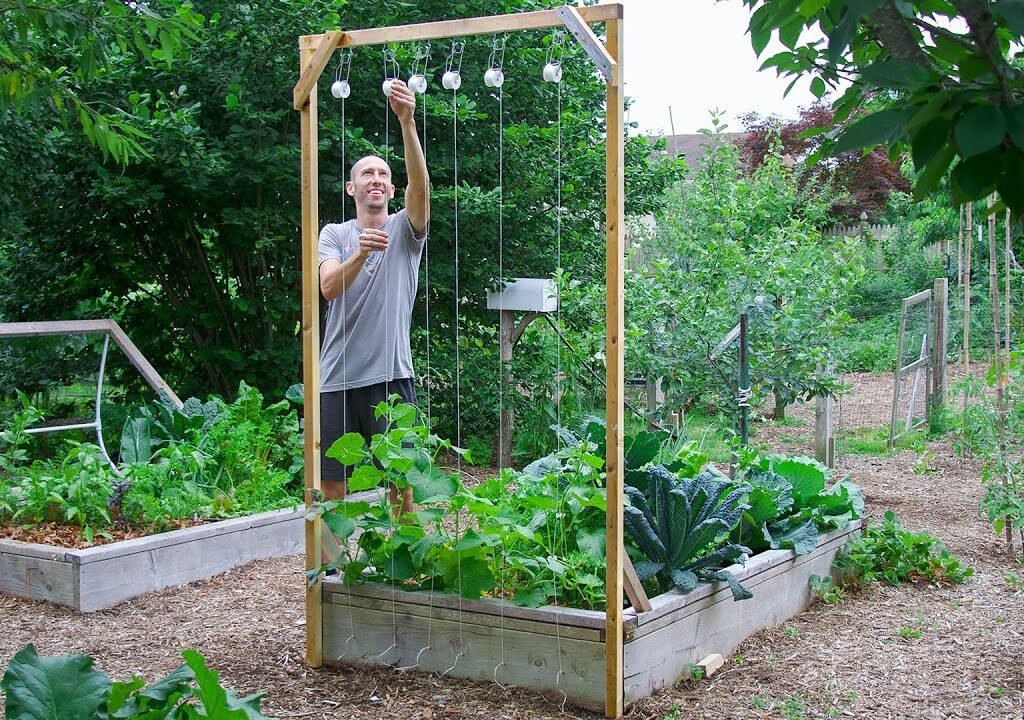
Cucumbers are mostly water — literally! So consistent moisture is key to their success, especially when growing vertically.
Watering Tips:
- Provide 1 inch of water per week, more in hot weather.
- Water at the base of the plants to avoid wetting leaves.
- Keep the soil evenly moist, not soggy.
Feeding Schedule:
- When vines begin running, feed every 2–3 weeks with a balanced fertilizer (like 10-10-10).
- Once flowers appear, switch to a fertilizer higher in potassium and phosphorus to encourage fruiting.
Mulch around the base of plants to conserve moisture and reduce weed competition.
Step 6: Encourage Pollination
Healthy cucumber vines need pollination for fruit to form. When you grow vertically, flowers are elevated and more visible to pollinators — a big advantage!
To attract bees and butterflies:
- Plant borage, zinnias, or marigolds nearby.
- Avoid pesticides during blooming periods.
If pollination still seems low (few fruits forming), you can hand-pollinate by gently transferring pollen from male flowers to female ones using a small brush or cotton swab.
Step 7: Prune for Better Airflow and Fruit Production
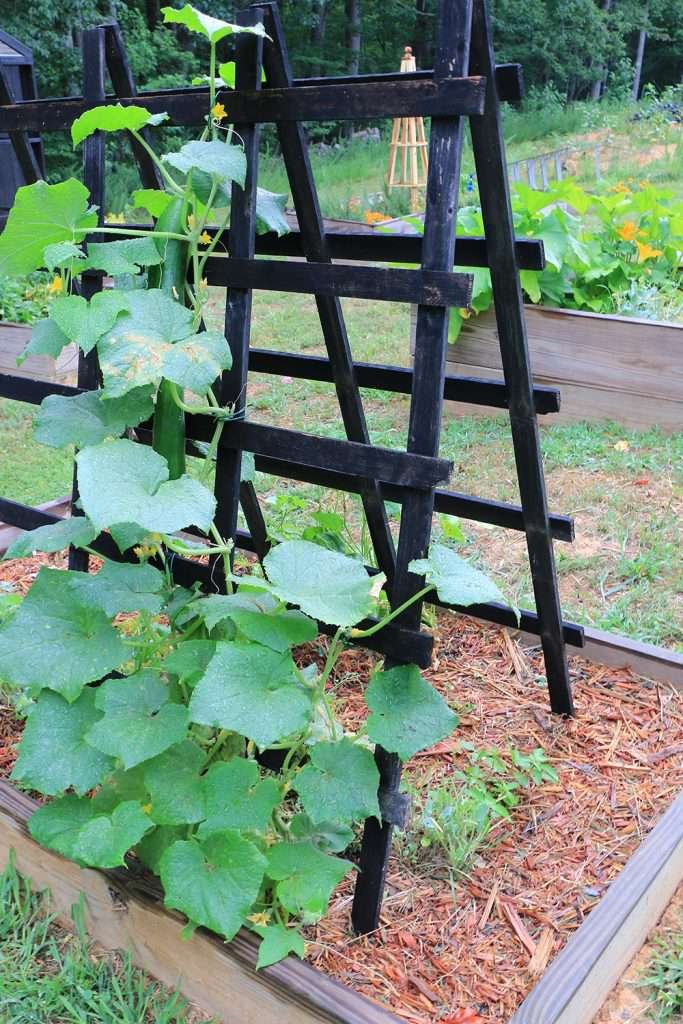
Pruning helps cucumbers focus their energy on fruit rather than endless vine growth.
How to Prune Climbing Cucumbers:
- Remove yellowing or damaged leaves near the base.
- Pinch off small side shoots once the main vine is about 2 feet long.
- Keep 2–3 strong lateral vines for fruiting; remove excessive runners that crowd the trellis.
- Avoid over-pruning — cucumbers still need plenty of leaves for photosynthesis.
Good airflow around the vines reduces the risk of mildew and keeps plants productive throughout the season.
Step 8: Harvesting Made Easy
One of the biggest perks of growing cucumbers vertically is how simple harvesting becomes. The fruits hang down clearly from the trellis, making it easy to spot them at the perfect size.
Harvest Tips:
- Pick cucumbers regularly (every 1–2 days) to encourage more fruit.
- Use scissors or pruners instead of pulling — stems can tear easily.
- Harvest when fruits are firm, evenly colored, and about 6–8 inches long for slicers, or smaller for pickling types.
Overripe cucumbers left on the vine slow down further production, so stay vigilant!
Troubleshooting Common Issues
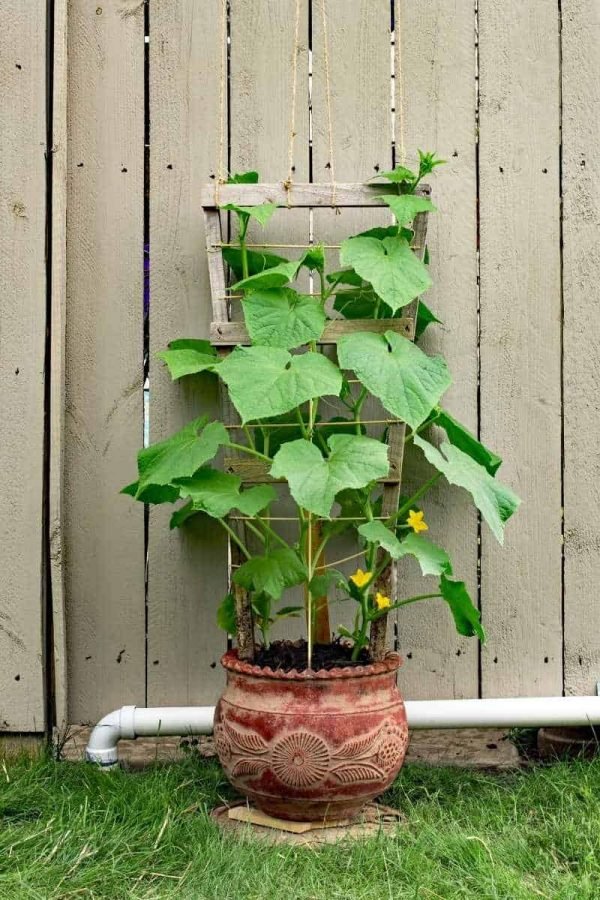
Even with great support, cucumber vines can face a few challenges. Here’s how to handle them:
- Vines slipping off the trellis: Tie them loosely with soft ties or clips.
- Fruits curling or growing oddly shaped: Often due to uneven pollination or lack of support — make sure fruit hangs freely.
- Powdery mildew: Improve airflow and water early in the day.
- Aphids or cucumber beetles: Spray with neem oil or introduce ladybugs for natural control.
Final Thoughts
Supporting cucumbers the right way turns a messy garden patch into a tidy, productive, and beautiful space. With a sturdy trellis and consistent training, your vines will grow strong, your fruit will stay clean, and harvesting will be a breeze.
Whether you’re working with a sprawling backyard or a small patio container, vertical cucumber growing is one of the smartest and most rewarding techniques any gardener can master.
So this season, let your cucumbers climb — and watch your garden (and harvest) reach new heights!
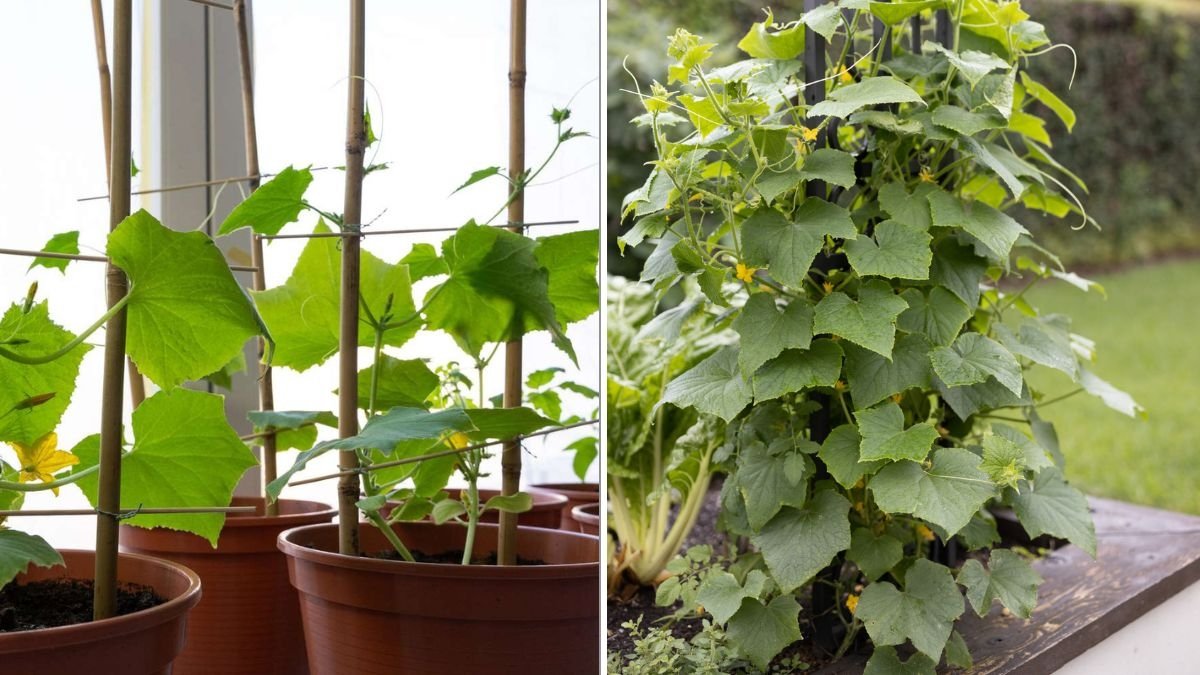





Leave A Comment